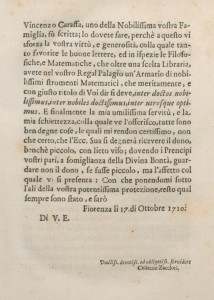 Earlier this semester we displayed a selection of Special Collections’ early modern science books for a group of students and faculty. Among the exhibited volumes was a copy of the second Italian edition of Galileo Galilei’s Dialogo or Dialogue concerning the two chief world systems, Ptolemaic and Copernican, published in 1710.
Earlier this semester we displayed a selection of Special Collections’ early modern science books for a group of students and faculty. Among the exhibited volumes was a copy of the second Italian edition of Galileo Galilei’s Dialogo or Dialogue concerning the two chief world systems, Ptolemaic and Copernican, published in 1710.
Something that intrigued several students was the fact that the book’s title page lists ‘Fiorenza’ (Florence) as publication place, whereas the bibliographic record states that the book was actually printed in Naples. While I was able to explain this in general terms with the then rather common practice of falsifying publication information as a protection from censorship, I was curious to find out a bit more about this particular case.
When Galileo (1564-1642) first published his Dialogo in 1632, defending the Copernican heliocentric view of our cosmos, the Catholic Church put him under house arrest and banned not just the Dialogo but also all of Galileo’s earlier writings. This censorship only fueled the demand for his works and several editions of his writings were published in France, England and the Netherlands throughout the 17th century. But as far as Italian editions were concerned, the 1710 printing of the Dialogo was only the second of its kind, due to the fact that it remained on the Index of Forbidden Books. And so it should not come as a surprise that an identifying printer’s mark or publisher’s device was missing from the volume. With this information missing, how do we know who was responsible for this clandestine undertaking? And that it had indeed taken place in Naples instead of Florence?
The sources I consulted enlightened me to the fact that the introductory letter to the reader at the beginning of the volume provides us with an important clue: the signature Cellenio Zacclori is (with the exception of one missing letter) an anagram for Lorenzo Ciccarelli, a Neapolitan lawyer who ran a print shop in Naples that specialized in the publication of forbidden books.
According to Vincenzo Ferrone, there is evidence that Ciccarelli’s shop was tolerated by some of the more progressive members of the Catholic Church, which helps to explain how we was able to elude shut-down by the authorities. Both Ferrone and Mayaud, both cited below, are fascinating reads if you are interested in the history of science and the enlightenment.
 Last page of Cicarelli’s letter to the readers, signed ‘Cellenio Zacclori.’
Last page of Cicarelli’s letter to the readers, signed ‘Cellenio Zacclori.’
Sources:
Ferrone, Vincenzo. 1995. The intellectual roots of the Italian Enlightenment: Newtonian science, religion, and politics in the early eighteenth century. Atlantic Highlands, N.J.: Humanities Press, p. 34-35, 186-187, 334.
Mayaud, Pierre-Noël. 1997. La condamnation des livres coperniciens et sa révocation à la lumière de documents inédits des Congrégations de l'Index et de l'Inquisition. Roma: Editrice Pontificia Università Gregoriana, p. 113-118.